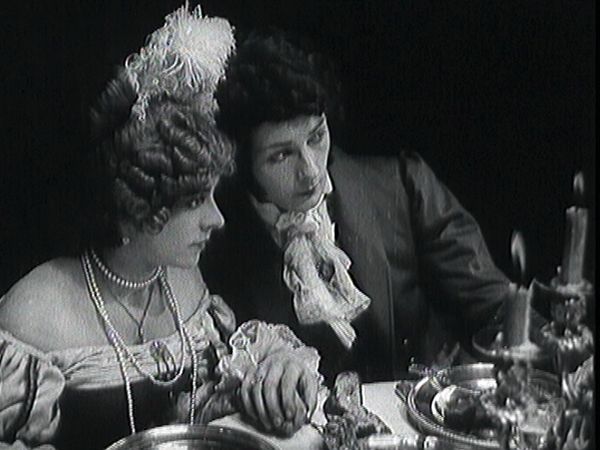L’AUBERGE ROUGE
(L’albergo rosso)
Jean Epstein (FR 1923)
Richard Abel, Anne-Marie Baron, and Andrew Watts are among the few scholars who’ve accorded L’Auberge rouge the attention it deserves in Jean Epstein’s storied career. Made for Pathé Consortium following the director’s debut with the docu-drama Pasteur (1922), the film is a prescient display of Epstein’s exploration of psychological expression through cinematic techniques of montage and close-ups, heralding the more avant-garde approach of La Chute de la maison Usher (1928). Given that Balzac’s short story (published the same year as “La Grande Bretèche”) toys with narrative construction, it’s more than tempting to suggest that Epstein carefully selected the source material in order to experiment with his firmly expressed film theories.
The original tale begins at an haut-bourgeois Parisian dinner party at which a Nuremberg merchant is induced to entertain the guests with “a dreadful, thrilling German story.” He obliges with a true account of a friend, Prosper Magnan, who several decades earlier was travelling with a colleague in the Rhineland when they stopped at an inn. Only one room was available, which they generously agreed to share with a latecomer, a merchant with a satchel full of gold and diamonds. Magnan was tempted almost beyond reason to murder the merchant and steal the treasure, but recoiled from his base thoughts and raced out of the inn to collect himself. Once back, he fell asleep, only to awaken in a pool of blood: his companion had slit the man’s throat and escaped with the bag. During the storytelling, the growing discomfort of one of the dinner guests, Jean-Frédéric Taillefer (a character also in Père Goriot), makes the reader understand that he was the murderous colleague.
A great deal of attention was paid to the shooting of the film in the contemporary French press, including two detailed descriptions of on-set visits, the first by Albert Bonneau, published in Cinémagazine on 23 March 1923, and the second by Jean Eyre, in Mon Ciné on 21 June. In Epstein’s own words, as quoted by Bonneau, “I sought to make a film based not on scrupulous staging, but on a thorough psychological study of the characters… My drama will not be ‘external,’ seeking to seduce the eye, but solely ‘internal’; its aim will be above all to capture the hearts of the spectators.” Epstein was perhaps a tad disingenuous, as L’Auberge rouge certainly does seduce the eye while also drawing out the characters’ psychological states: as Anne-Marie Baron writes in her online essay about the film, “The piercing gaze of the Balzacian observer-narrator inspires the inquisitive lens of Epstein’s camera.”
Epstein made several changes to the original text, though to Bonneau he admitted only to shifting the setting from Germany to Alsace (Le Petit Journal, 28 September 1923, also noticed that Magnan and his colleague were transformed from army surgeons to civil ones). Oddly no one pointed out the addition of a fortune-telling old hag (Madame Delaunay), while the character of the innkeeper’s daughter (Gina Manès) was clearly added to provide a romantic subplot. Yet Jean de Mirbel, in Cinémagazine (3 August 1923), applauded that of all directors who attempted to adapt Balzac on screen, it was Epstein alone who “knew how to stand in the shadow of the great author and give his own work all the picturesque qualities and realism the novelist brought to his book.”
The reasons for trusting in this fidelity are obvious: it’s not just that Epstein starkly captures Magnan’s nightmarish feeling of culpability with bravura montage, but his cutting back and forth between the dinner party and the story itself parallels Balzac’s shifts between the two, reinforcing character while expertly stretching the tension with each narrative jump. The director was correct in speaking of this as an “internal” film: the rapidly edited close-ups of Magnan (Léon Mathot) with hallucinatory images of diamonds and rain convey his excruciating inner torment, while the celebrated scene in which he races out into a storm (witnessed on-set by Eyre) further illustrate his psychological state, recognized by Richard Abel as Epstein’s earliest use of camera and editing to bring together objective and subjective points of view.
Critics of the time made much of these visual techniques, noting the travelling shots at the dinner party and praising cinematographer Raoul Aubourdier, who’d previously worked closely with Raymond Bernard (and would later collaborate with Mario Bonnard on Der goldene Abgrund). Just as Balzac detailed, throughout the Comédie Humaine, how individuals viewed one other, so too Epstein gives considerable attention to where and how people look, ensuring that the gaze silently conveys almost as much interior information as the master’s pen.
Jay Weissberg

regia/dir, scen: Jean Epstein, dal racconto di/based on the short story by Honoré de Balzac (1831).
photog: Raoul Aubourdier, asst. Roger Hubert, Robert Lefebvre.
scg/des: [Georges] Quénu.
asst dir: Jaque Christiany.
cast: Léon Mathot (Prosper Magnan), Jean-David Evremond (Jean-Frédéric Taillefer), Pierre Hot (locandiere/innkeeper), Gina Manès (la figlia del locandiere/innkeeper’s daughter), Marcelle Schmit (Victorine Taillefer), Jaque Christiany (André), Robert Tourneur (Herman), Mme. Delaunay (la strega/old hag), Clairette de Savoye (la moglie del locandiere/the innkeeper’s wife), Thomy Bourdelle (l’olandese/the Dutchman), Luc Dartagnan (fisarmonicista/accordion player), René Ferté, Henri Barat, André Volbert (i giudici/the judges), Hugues de Bagratide (mercante ebreo/a Jewish merchant), Mme. Courtois (ospite/dinner guest).
prod: Louis Nalpas, Pathé Consortium Cinéma.
dist: Pathé.
riprese/filmed: 02–04.1923: studio Vincennes; 02–03.1923: Château de Vincennes (“La Caponnière”).
anteprima per esercenti/trade screening: 18.07.1923.
uscita/rel: 28.09.1923.
copia/copy: DCP, 73′ (da/from 35mm, 1642 m., orig. 1835 m., 20 fps); did./titles: FRA.
fonte/source: Gaumont Pathé Archives, Saint-Ouen, Paris.


 Italiano
Italiano